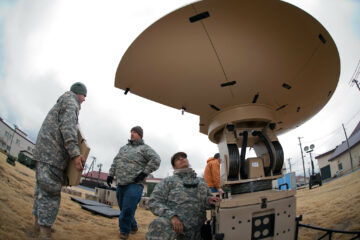COLORADO SPRINGS — Following the Pentagon’s recent guidance urging greater use of commercial space technologies, the U.S. Space Force on April 10 released its own blueprint for integrating private-sector capabilities.
In a speech at the 39th Space Symposium, Chief of Space Operations Gen. Chance Saltzman said the strategy serves as foundational guidance for military and civilian leaders tasked with identifying future space needs, securing funding, and acquiring necessary technologies.
Saltzman said the strategy formalizes how the Space Force plans to move forward working with commercial industry to drive development of more resilient and combat-capable architectures while deploying them faster, in greater numbers and at a lower cost.
“The Space Force is committed to enhancing its partnerships with the commercial space industry, our allies and other international partners,” he said.
“Today we find ourselves in the midst of a great power competition with our adversaries,” Saltzman added. “Cooperation among industry leaders and allies has proven particularly effective in challenging Russia’s efforts in Ukraine. And throughout our nation’s history, military success has hinged on support from commercial industry.”
‘Not a panacea’
Saltzman in his remarks tempered expectations, noting the highly anticipated commercial strategy document is not a cure-all.
“It is not a panacea. It does not provide all the answers,” he said. “But I do think it frames the discussion that must take place. It sets the conditions for productive collaboration, and it starts the critical processes needed to accelerate the purposeful pursuit of hybrid space architectures.”
A dominant narrative is the concept of hybrid architectures — where the Space Force will combine U.S. government assets, allied contributions, and commercially developed systems.
Saltzman cautioned that anyone who expects the strategy to be a silver bullet solution will be let down.
“In fact, if you read this strategy expecting to see the answers to the most challenging problems of commercial integration, you will be disappointed,” he said.
“If you are expecting the document to outline how much money is available for us to dole out for each mission area, you will be disappointed.”
However, “if you understand that effective integration will only come about with a common understanding of our priorities, the missions where we need help, our proposal evaluation criteria and clear definitions of terms to enhance that collaboration. I think you’ll find this document useful as a tool to drive process change, to shift our mindset and useful to see the space Force’s relationship with industry in a new light.”
In crafting its commercial space strategy, Saltzman said, the Space Force convened two focus groups, gathering input from industry leaders, think tank experts, and government officials. The draft strategy was also circulated more widely, with hundreds of people providing feedback.
‘Tough choices’
Depending on available resources and funding, he said, “we are going to have to make trades between what we buy and what we build. Therefore, we are challenging the team to identify how best to optimize our resources as we work to deliver space capabilities needed by the Joint Force.”
To help the industry understand the military’s thinking, the commercial space strategy outlines broad criteria that will be used to evaluate industry proposals.
The first is operational utility, or the ability to satisfy a needed requirement for Space Force operations in support of a joint campaign. “We are not just buying things because we can. We will be contracting for capabilities that directly enable us to satisfy service or joint requirements and are clearly traceable to those requirements,” said Saltzman.
The second consideration is the cost to acquire and exploit a technology “at sufficient value and at a cost that the Space Force is prepared to resource,” he said. An example is evaluating whether to purchase time on a commercial ground architecture for telemetry tracking and commanding versus buying new antennas for the military’s satellite control network.
Another criteria is commercial systems’ ability to improve resilience and reduce risks to military users. “Commercial space capabilities enhance our capacity and resiliency, but only if they contribute to defense,” said Saltzman. The more desirable commercial systems are those “able to protect themselves or operate effectively under contested circumstances.”
How quickly a technology can be fielded and put to operational use is another concern. “Time matters because we are running out of it,” said Saltzman. “The timeline from concept to operational capability will be important. We don’t have the luxury of waiting years for programs to deliver.
“We will evaluate commercial capabilities not just on their level of innovation and capability, but also on the timeline to get it to the field and available for use by the Joint Force,” he added.
Saltzman echoed concerns raised by Secretary of Defense Lloyd Austin in DoD’s commercial space integration strategy.
Austin warned that commercial technologies should be integrated, as opposed to merely augmenting existing government systems. Saltzman said he agreed that this will require a shift in approach within the department.
‘Mission areas’
Tactical surveillance, reconnaissance, and tracking; space-based environmental monitoring; positioning, navigation and timing, and space access mobility and logistics are highlighted as the top mission areas targeted for new commercial integration. Existing areas of commercial collaboration, such as satellite communications, launch services, and space domain awareness, will continue to receive investment.
“The Space Force is undergoing a significant shift,” the strategy states. “We require stronger partnerships with commercial and allied entities to establish hybrid space architectures. These architectures will integrate Department of Defense, commercial, and allied space systems, resulting in more resilient, redundant, and combat-ready capabilities.”
- SEO Powered Content & PR Distribution. Get Amplified Today.
- PlatoData.Network Vertical Generative Ai. Empower Yourself. Access Here.
- PlatoAiStream. Web3 Intelligence. Knowledge Amplified. Access Here.
- PlatoESG. Carbon, CleanTech, Energy, Environment, Solar, Waste Management. Access Here.
- PlatoHealth. Biotech and Clinical Trials Intelligence. Access Here.
- Source: https://spacenews.com/space-force-unveils-strategy-to-leverage-commercial-tech-innovation/
- :has
- :is
- :not
- :where
- 1
- 10
- 12
- 13
- 17
- 19
- 24
- 300
- 41
- 46
- 5
- 50
- 6
- a
- ability
- About
- accelerate
- access
- acquire
- acquiring
- added
- again
- agreed
- Alert
- All
- also
- among
- an
- and
- Another
- answers
- Anticipated
- anyone
- approach
- April
- architecture
- architectures
- ARE
- AREA
- areas
- AS
- Assets
- At
- austin
- available
- awareness
- BE
- because
- BEST
- between
- broad
- build
- but
- button
- buy
- Buying
- by
- Campaign
- CAN
- capabilities
- capability
- Capacity
- challenging
- Chance
- change
- chief
- circumstances
- civilian
- clear
- clearly
- Close
- collaboration
- combine
- come
- commercial
- commercially
- committed
- Common
- Communications
- competition
- concept
- Concern
- Concerns
- conditions
- consideration
- continue
- contracting
- contribute
- contributions
- control
- convened
- Cost
- couldn
- crafting
- criteria
- critical
- day
- Defense
- definitions
- deliver
- Department
- department of defense
- deploying
- developed
- Development
- directly
- disappointed
- discussion
- do
- document
- does
- Dole
- domain
- dominant
- Dont
- down
- draft
- drive
- each
- echoed
- Effective
- effectively
- efforts
- enable
- enhance
- enhancing
- entities
- environmental
- error
- establish
- Ether (ETH)
- evaluate
- evaluating
- evaluation
- example
- existing
- expectations
- expecting
- expects
- experts
- Exploit
- fact
- false
- faster
- feedback
- field
- Find
- First
- Focus
- following
- For
- Force
- Forward
- foundational
- from
- funding
- future
- gathering
- Gen
- get
- going
- Government
- Government Officials
- great
- great power
- greater
- Ground
- Group’s
- guidance
- Have
- he
- help
- Hidden
- Highlighted
- highly
- his
- history
- How
- HTTPS
- Hundreds
- Hybrid
- i
- identify
- identifying
- if
- important
- improve
- in
- industry
- Innovation
- input
- integrate
- integrated
- Integrating
- integration
- International
- investment
- IT
- ITS
- joint
- journalist
- just
- latest
- launch
- leaders
- let
- Level
- Leverage
- light
- List
- logistics
- lower
- Luxury
- make
- Matters
- max-width
- merely
- Military
- Mindset
- Mission
- missions
- mobility
- money
- monitoring
- more
- most
- move
- move forward
- much
- must
- NARRATIVE
- Nations
- Navigation
- necessary
- Need
- needed
- needs
- network
- New
- Newsletter
- noting
- numbers
- of
- officials
- on
- only
- operate
- operational
- Operations
- opposed
- Optimize
- or
- Other
- our
- ourselves
- out
- outline
- outlines
- own
- page
- panacea
- particularly
- partners
- partnerships
- People
- Place
- plans
- plato
- Plato Data Intelligence
- PlatoData
- please
- pop-up
- positioning
- power
- prepared
- problems
- process
- processes
- productive
- Programs
- proposal
- Proposals
- protect
- proven
- provide
- providing
- publish
- purchase
- pursuit
- put
- quickly
- raised
- RE
- Read
- receive
- reduce
- redundant
- relationship
- require
- requirement
- Requirements
- resilience
- resilient
- resource
- Resources
- resulting
- risks
- running
- s
- Said
- satellite
- satisfy
- Second
- secretary
- securing
- see
- serves
- service
- Services
- Sets
- shift
- should
- significant
- Silver
- solution
- Space
- Space Force
- space industry
- space-based
- speech
- starts
- States
- Status
- Strategy
- stronger
- subscription
- success
- such
- sufficient
- support
- surveillance
- Symposium
- Systems
- T
- Take
- tank
- targeted
- tasked
- team
- tech
- Technologies
- Technology
- terms
- that
- The
- the joint
- their
- Them
- themselves
- There.
- therefore
- These
- they
- things
- Think
- think tank
- Thinking
- this
- those
- throughout
- time
- timeline
- timing
- to
- tool
- top
- traceable
- Tracking
- trades
- true
- try
- Tuesday
- two
- u.s.
- U.S. government
- U.S. Space Force
- Ukraine
- under
- undergoing
- understand
- understanding
- Unveils
- urging
- us
- use
- used
- useful
- users
- utility
- value
- Versus
- veteran
- Waiting
- warned
- was
- we
- What
- whether
- while
- WHO
- widely
- will
- with
- within
- Work
- working
- years
- you
- Your
- zephyrnet











